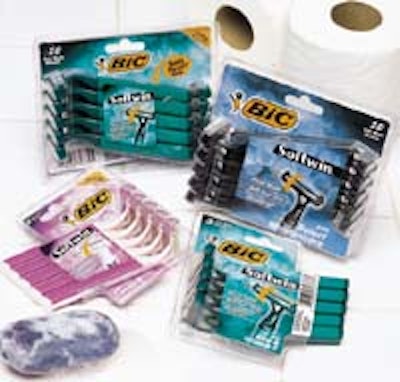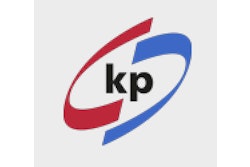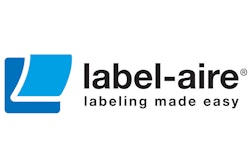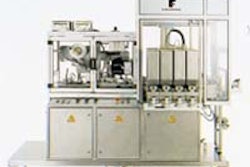Easy opening and reclosability were just two of the requirements imposed by marketers.
In the language of personal care retailers, BIC Consumer Products’ new Softwin™ line of products is called a “one-piece shaver” while blade and refillable blade combos are called “shaving systems.” Gone are the days of calling these “disposable razors,” which connotes a commodity product and, most certainly, a commodity-type package.
The Softwin product and package from BIC are anything but a commodity. The U.S. arm of BIC, headquartered at Milford, CT, justifiably calls Softwin a “premium” product and its new package not only reflects that image, but enhances it via extra features not found on any competitive packaging. And, in fact, some package functions that weren’t even considered in the past.
The new Softwin blister packs had to meet a sweeping list of requirements laid out by BIC’s marketing group. They included:
• The five-pack had to fit into the footprint or package dimension dictated by retailers with fixed-position, planogram-style pegboard displays. The 10-pack was designed for a smaller footprint than a traditional 10-pack to encourage retailers to peg it, rather than display it in a bin.
• The blister pack, insert card and label had to convey the premium image of the product and offer excellent product visibility for the consumer. That allows the shopper to view the product’s dual lubrication strips and the twin-blade shaving head.
• Both packages had to permit the shopper to touch the Soft Feel™ grip on the shaver’s handle. This is accomplished by having the handles protrude out the side of the five-pack package, and via a die-cut opening on the back of the 10-pack blister.
• The design of the five-pack insert cards and the blisters had to accommodate what BIC calls “collating” on the peg. To place more packs on a peg, the blister packs are alternately loaded, back first, front first and so on.
• The package had to be tamper-evident, yet easy to open. It also needed to provide reclosability. The two-blister pack is sealed by radio-frequency (RF) for tamper-evidence. It also uses perforations on three sides with a pull-tab for easy opening. Once opened, however, the pack can be reclosed for home storage. Plus, the new packs had to employ the Euro-style hanger hole, just in case BIC decided to sell it overseas.
At first glance, the new BIC packs look like straightforward blister packs with bright insert cards printed to color coordinate with the shavers. Once all the package features are examined, however, it’s obvious why BIC has a patent application pending on the package design.
There’s one other major reason why the manufacturer expects to have patent protection on the package. Although the primary package development took place at BIC, with help from several suppliers in the U.S., the actual packaging of the shavers takes place in Greece!
If that’s surprising, Greece is where the shavers are produced. So packaging in the same facility that manufactures them is less unusual. And while the blisters and the sealing system were developed by Alloyd Corp. (DeKalb, IL), someday soon the blister manufacture will shift to Greece.
That’s already happened for the insert card and a matching label. The design and early quantities of cards and labels were produced by Scott & Daniells (Portland, CT) and PromoEdge (Neenah, WI) respectively. Card and label converting for the packs now is coming from sources close to the Greece production facility.
“The shavers are made in Greece and that’s why they’re packaged there,” says Christian Keator, packaging engineering and merchandising manager for BIC. “All of the design work on the package and the production of the materials were done here in the U.S. so we could control the quality of the materials, the colors and other variables. For the initial build and launch, we wanted to get the project going with U.S. suppliers. Later, we knew we’d shift to sources close to the production plant.”
U.S. pack only
Alloyd forms the five-pack blisters from 12 ?-mil polyvinyl chloride sheet that Alloyd makes or buys from Klöckner Pentaplast of America (Gordonsville, VA). The 10-packs use the same material for the back, but 15-mil PVC forthe front.
Inserts are 12-pt SBS, coated two sides and printed offset in either three or four colors. The labels are 60# high-gloss stock that’s printed rotary letterpress in three colors plus a UV varnish.
These packages currently are only used for U.S. distribution. The same shavers in different packaging were first launched in Greece about a year ago. The product/package combos were previewed by U.S. buyers last November, while Softwin was shipped for a March 1 launch at retail.
The packaging project actually began in ’98. And while production on the U.S. pack began last year, it actually occurred in two stages. For what Keator calls the “initial build,” BIC purchased a shuttle-type RF sealer made by Callanan (Elk Grove Village, IL), an Alloyd subsidiary. With its short lead time for delivery, the shuttle-type sealer allowed BIC’s plant in Greece to begin production on a semi-automatic basis in late spring of ’99. After the finished packs were tested, BIC ordered two Alloyd automated carousel lines that were installed in mid-November.
“For the initial production, we ended up hand-packing the shavers and used the Callanan shuttle system to perform the radio-frequency sealing,” Keator recalls. “We did that for about six months, until the automated lines were installed in our plant.” While the plant was hand-packing, the plant in Greece used a single insert card with score lines for two folds around the shavers. After the automatic carousel lines were installed, the only operations still done by hand were the loading of the shavers into the blisters and packing into chipboard boxes and master cases.
Both the product and package are unique. What distinguishes Softwin is that it’s the only one-piece shaver that has a pivoting head, two lubrication strips, twin blades and the soft grip handle.
The package, at least in the shaver category, is notable for its easy opening and reclosability. Some competitors have blister packs or paperboard sleeves that let consumers touch them. But those packs don’t provide reclosability nor product security, Keator explains.
Size a major obstacle
To deliver all the package features and meet the size requirements was especially difficult, Keator recalls. To accomplish both tamper-evident RF seals and easy opening, Alloyd actually perforates the pack in the flange area.
“On most perforated blisters, the perfing is done in the blister platform away from the flange,” Keator says. “But to perforate the platform where the shaver heads are located would have made the package wider than we wanted. We would have had to draw in between the shaver head part of the blister and the flange. Plus it would have complicated the forming and perfing process.
“To avoid that, Alloyd worked to perf the blister right in the flange. As tough as that is to accomplish, it made locating the pull-tab a bit easier. There is a lot of technology in this package.” The perforation and the die-cut pull-tab have been done by Alloyd in the past, but usually only for costly cosmetics packs, says Kent Hayward, marketing communications manager for Alloyd.
RF seal first
Similarly, the supplier had to stretch technology when it came to the RF sealing. On the five-pack, the handles are exposed on one side so the RF seal is interrupted. While this can be accomplished via heat-sealing, an interrupted seal area is a technical achievement in RF sealing, both BIC and Alloyd agree.
“At first, we were told that radio-frequency seals had to be full-loop without interruption,” Keator says. To expose the shaver handles when they’re loaded, a side of the blister is removed by a guillotine cut after thermoforming. However, the resulting opening in the package perimeter had the potential to damage the RF tools because of electrical arcing.
Eventually, BIC packaging designers brainstormed with Callanan technical people, and Callanan’s president, Steve Myers, developed custom tooling that was designed to eliminate the problem. “This is just one reason why we’re patenting this package,” says Keator. “This type of radio-frequency seal hasn’t been done before.”
BIC’s packaging manager also boasts about a design advantage that can’t even be seen yet. “Our blister design, unlike any other that I know of, is ready to accommodate an extra shaver, what we typically call a bonus pack,” he says. “Our five-pack design will actually accommodate a sixth shaver in the same footprint.”
Oh, those buffer sheets!
Packaging engineer Mike Osber says that installation and start-up of the two production lines (see sidebar, p. 33) went better than expected. However, he says, the most vexing problem was to find buffer stock in Greece. Buffers are paper-like sheets that mask the aluminum nesting plates from the RF sealing tools.
Without buffer sheets, the RF sealing station would operate much like a microwave oven with aluminum foil in it—arcing and shutting down. Although BIC couldn’t find a local supplier, it wasn’t difficult to buy the buffer stock from Callanan and ship it to the plant in Greece.
And shipping—whether it’s blisters from Alloyd or buffer stock from Callanan to Greece, or finished packages from Greece to the U.S.—isn’t the issue it might have been a few years ago. “Speed to market is not a high priority in a project like this,” says Keator. “We had a lot of lead time, both in product and package development and in getting the automated equipment installed. It required crucial planning upfront because of shipping times.” Products might be on a freighter for four to five weeks, door to door, he notes. But it’s been worth the wait.
“Retailer reaction has been overwhelming,” reports Heather Kilgore, shaver product manager. “To date, 95 percent of the accounts that we presented this line to have placed orders.” That enthusiasm, Kilgore says, stems from the extensive testing the company performed on the product and later on the packaging, too.
“We haven’t yet had a lot of comments about our packaging from the marketplace,” she says. “But, our competitors have certainly shown a lot of interest in it. They’ve already contacted several of our suppliers about it.”
See sidebar to this article: Two-pack, too
In a hurry? Request more info via Web-based reader service by clicking on the reader service number.
Or you can jump right to their Web site.


























